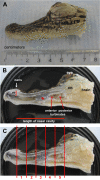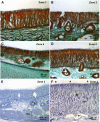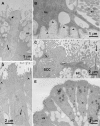Olfactory and solitary chemosensory cells: two different chemosensory systems in the nasal cavity of the American alligator, Alligator mississippiensis
- PMID: 17683564
- PMCID: PMC1950884
- DOI: 10.1186/1471-2202-8-64
Olfactory and solitary chemosensory cells: two different chemosensory systems in the nasal cavity of the American alligator, Alligator mississippiensis
Abstract
Background: The nasal cavity of all vertebrates houses multiple chemosensors, either innervated by the Ist (olfactory) or the Vth (trigeminal) cranial nerve. Various types of receptor cells are present, either segregated in different compartments (e.g. in rodents) or mingled in one epithelium (e.g. fish). In addition, solitary chemosensory cells have been reported for several species. Alligators which seek their prey both above and under water have only one nasal compartment. Information about their olfactory epithelium is limited. Since alligators seem to detect both volatile and water-soluble odour cues, I tested whether different sensory cell types are present in the olfactory epithelium.
Results: Electron microscopy and immunocytochemistry were used to examine the sensory epithelium of the nasal cavity of the American alligator. Almost the entire nasal cavity is lined with olfactory (sensory) epithelium. Two types of olfactory sensory neurons are present. Both types bear cilia as well as microvilli at their apical endings and express the typical markers for olfactory neurons. The density of these olfactory neurons varies along the nasal cavity. In addition, solitary chemosensory cells innervated by trigeminal nerve fibres, are intermingled with olfactory sensory neurons. Solitary chemosensory cells express components of the PLC-transduction cascade found in solitary chemosensory cells in rodents.
Conclusion: The nasal cavity of the American alligator contains two different chemosensory systems incorporated in the same sensory epithelium: the olfactory system proper and solitary chemosensory cells. The olfactory system contains two morphological distinct types of ciliated olfactory receptor neurons.
Figures








Similar articles
-
Diversity in the olfactory epithelium of bony fishes: development, lamellar arrangement, sensory neuron cell types and transduction components.J Neurocytol. 2005 Sep;34(3-5):183-208. doi: 10.1007/s11068-005-8353-1. Epub 2006 Jul 13. J Neurocytol. 2005. PMID: 16841163
-
Microvillous cells in the olfactory epithelium express elements of the solitary chemosensory cell transduction signaling cascade.PLoS One. 2018 Sep 13;13(9):e0202754. doi: 10.1371/journal.pone.0202754. eCollection 2018. PLoS One. 2018. PMID: 30212469 Free PMC article.
-
Is TrpM5 a reliable marker for chemosensory cells? Multiple types of microvillous cells in the main olfactory epithelium of mice.BMC Neurosci. 2008 Dec 4;9:115. doi: 10.1186/1471-2202-9-115. BMC Neurosci. 2008. PMID: 19055837 Free PMC article.
-
Fine structure of olfactory epithelia of gastropod molluscs.Microsc Res Tech. 1992 Sep 1;22(4):307-24. doi: 10.1002/jemt.1070220402. Microsc Res Tech. 1992. PMID: 1392062 Review.
-
Odorant receptor diversity and patterned gene expression in the mammalian olfactory epithelium.Prog Clin Biol Res. 1994;390:75-84. Prog Clin Biol Res. 1994. PMID: 7724652 Review.
Cited by
-
GABAergic modulation of olfactomotor transmission in lampreys.PLoS Biol. 2018 Oct 4;16(10):e2005512. doi: 10.1371/journal.pbio.2005512. eCollection 2018 Oct. PLoS Biol. 2018. PMID: 30286079 Free PMC article.
-
Synchrotron microtomography of a Nothosaurus marchicus skull informs on nothosaurian physiology and neurosensory adaptations in early Sauropterygia.PLoS One. 2018 Jan 3;13(1):e0188509. doi: 10.1371/journal.pone.0188509. eCollection 2018. PLoS One. 2018. PMID: 29298295 Free PMC article.
-
Bitter and sweet taste receptors in the respiratory epithelium in health and disease.J Mol Med (Berl). 2014 Dec;92(12):1235-44. doi: 10.1007/s00109-014-1222-6. Epub 2014 Nov 13. J Mol Med (Berl). 2014. PMID: 25391251 Free PMC article. Review.
-
Tuft cells in the pathogenesis of chronic rhinosinusitis with nasal polyps and asthma.Ann Allergy Asthma Immunol. 2021 Feb;126(2):143-151. doi: 10.1016/j.anai.2020.10.011. Epub 2020 Oct 26. Ann Allergy Asthma Immunol. 2021. PMID: 33122124 Free PMC article. Review.
-
Taste Receptors: Regulators of Sinonasal Innate Immunity.Laryngoscope Investig Otolaryngol. 2016 Aug;1(4):88-95. doi: 10.1002/lio2.26. Epub 2016 Jun 28. Laryngoscope Investig Otolaryngol. 2016. PMID: 27819057 Free PMC article.
References
-
- Farbman AI. Cell Biology of Olfaction. Cambridge University Press; 1992.
-
- Bannister LH. The fine structure of the olfactory surface of teleostean fishes. Quart J Microsc Sci. 1965;106:333–342.
Publication types
MeSH terms
Grants and funding
LinkOut - more resources
Full Text Sources

